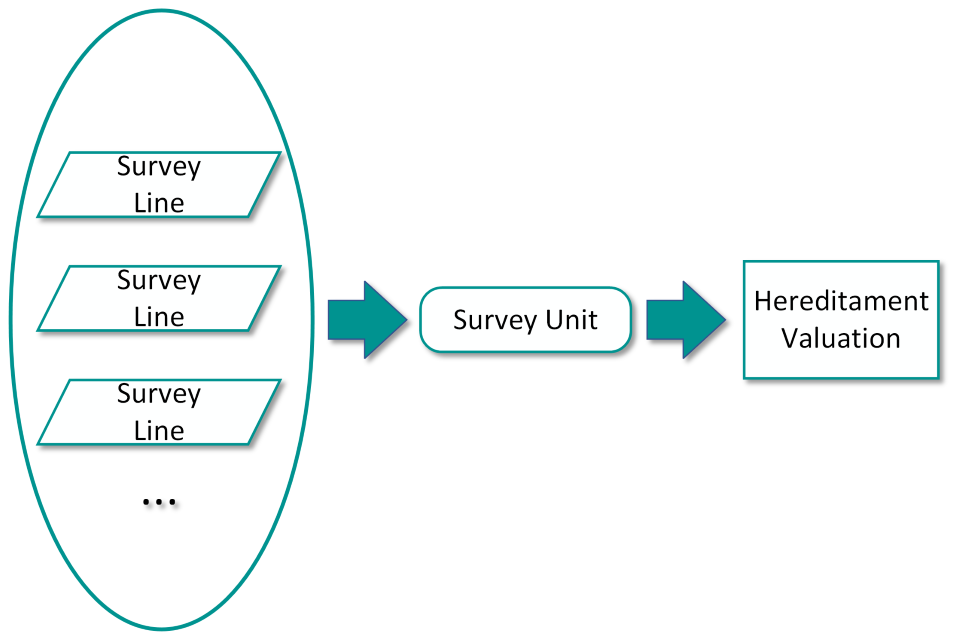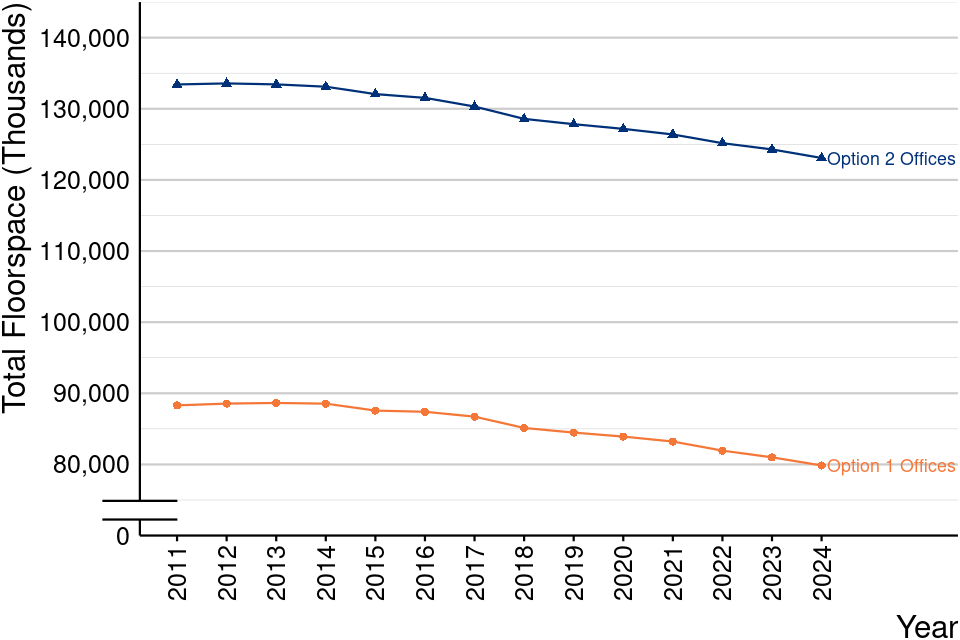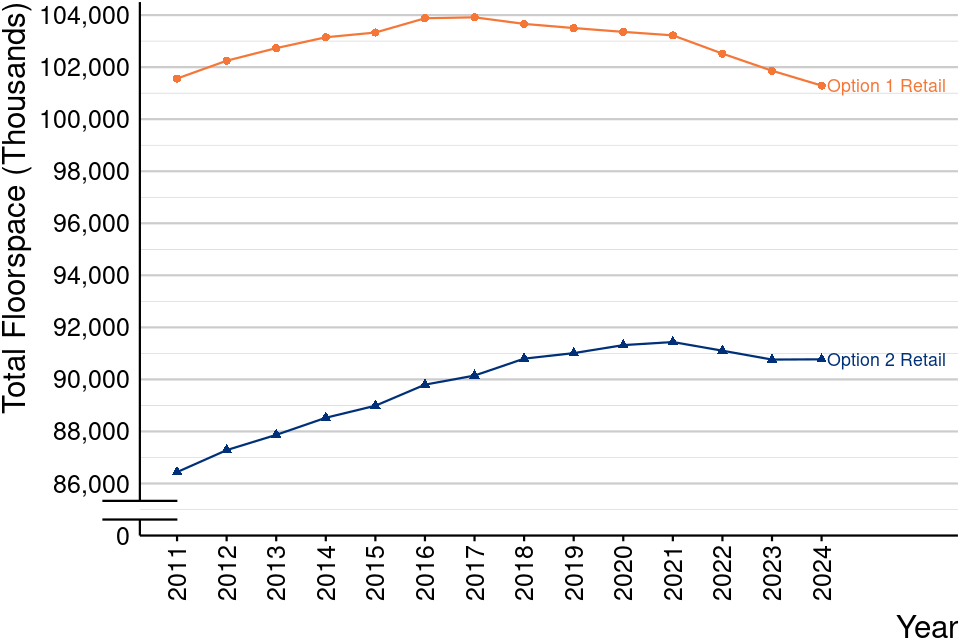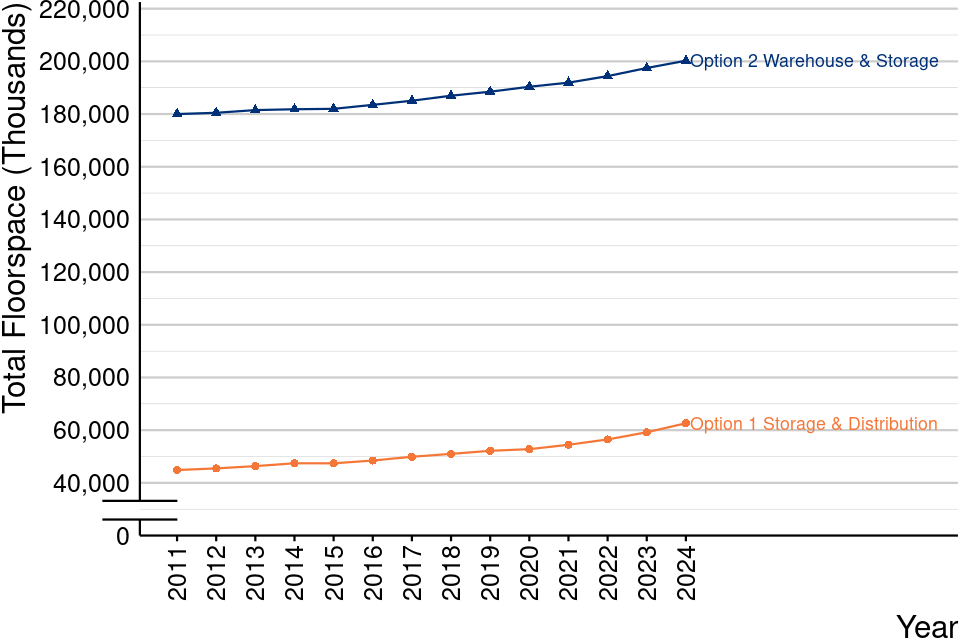Public Consultation on business floorspace statistics published by the Valuation Office Agency
Updated 25 March 2025
Executive summary
The Valuation Office Agency (VOA) aims to improve its statistics to ensure they continue to best meet the needs of users. Following a review of business floorspace statistics, we have identified two possible ways to measure and classify floorspace within the statistics. Floorspace can continue to be classified at an overall hereditament level; or floorspace can be measured at a more granular level and aggregated by the use of each section of a hereditament.
The purpose of the consultation is to understand how floorspace statistics are used and therefore which of the two methods will better meet user needs. The document sets out the broad differences in the two approaches and invites feedback from users. It is published alongside a Quality Assurance of Administrative Data (QAAD) report which provides more detail on our non-domestic property attribute data, to give users the necessary information to respond.
Users are invited to respond to the consultation questionnaire before its closing date on 30 January 2025.
Introduction
Since 2016 the VOA has published statistics on business floorspace and rateable value per metre squared, for non-domestic properties in England and Wales.
We have recently undertaken a review of the quality assurance and methodology of our statistics on business floorspace, using the Quality Assurance of Administrative Data (QAAD) toolkit, which is part of the best practice under the Code of Practice for Official Statistics. Its purpose is to improve both the quality of the outputs and value to users. The QAAD report published alongside this consultation provides information and assurance to users that the floor space data held by the VOA are monitored and suitable for the purpose of producing statistical outputs.
This public consultation is intended to help us establish the value of our approach. This is in line with Code of Practice for Statistics V1: Relevance to Users. Users of our statistics are at the centre of our statistical production: their needs should be understood their views sought and acted on, and their use of statistics supported. We understand that there are a range of users of our business floorspace statistics, and we wish to take in all views.
- Section 1 will explain the operational context and data structure of the VOAs property attribute and floorspace data.
- Section 2 will present two options which represent an improvement in quality of our current publication. The two options are not final and are still subject to change. Neither option is better conceptually or in terms of data quality, however it will only be practicable to produce statistics on one basis, to be informed by feedback from users via this consultation.
The annex provides background detail on the property sectors used in the statistics.
Any further comments can be addressed to statistics@voa.gov.uk.
Section 1 - Data Structure and Operational Context
Hereditament
For the purposes of valuation, the VOA identify properties as hereditaments. A hereditament is a unit of rateable occupation, broadly defined as a contiguous space with a common occupier. This is a legal definition set out in case law and can be subject to change. A hereditament is not the same as a building and it is not possible to identify buildings from the data. It may differ from other classifications of properties such as address or Unique Property Reference Number (UPRN).
Survey line
The valuation of a hereditament is made up of subsections known as survey lines. Survey lines are the most granular level of data captured and include details of segments of a hereditament with a defined use, such as an office space or a staff kitchen.
When used in a valuation, survey lines are aggregated into a single survey unit. The majority of bulk class hereditaments consist of only one survey unit so the hereditament and survey unit are classed as the same thing. More than one survey unit would be required where they are valued in different ways, for example a factory with land at the side. The information recorded in the survey lines and survey units are then used to assign a rateable value for the hereditament. This is done by valuers in line with the rating manual and using suitable multiplicative adjustments. Figure 1 illustrates this process.

Figure 1
Importantly for the purposes of floorspace statistics, it is at the survey line level that floor area is recorded by valuers, and thus the survey line is the main source of data for our production of business floorspace statistics. The options presented in this consultation provide details of the different ways this floor area data can be aggregated to provide the most value to users.
Categories of hereditaments and survey lines
Two types of distinct property space have been outlined above. Hereditaments and their constituent parts, survey lines. As part of the valuation process the VOA assigns categories to these property spaces that reflect their usage. Additionally, these categories can be used as groupings in the production of official statistics.
The VOA has several different types of property categories for the purpose of valuation and operational organisation. As part of the recent quality assurance work done on business floorspace data, two have been identified that are suitable for official statistics. These are ‘special category code’ at the hereditament level and ‘use code’ at the survey line level.
Special Category (SCat) – Classification assigned to the whole hereditament. This details the purpose for which the hereditament is valued and, in most cases, will reflect the hereditament’s primary use.
Use Code – Classification given to the survey line that reflects its usage and indicates to the valuer how much RV this survey line should contribute to the overall valuation of the hereditament.
For more detail on the quality of the property classifications used please see the QAAD report published alongside this consultation.
Scope of data considered
The VOA’s property attribute data is not uniformly recorded and accurate floorspace data is not available for all properties on the rating list. We have taken the decision to only produce statistics for bulk class properties, valued on a rental basis, this represents about 90% of properties on the rating list.
For a rental based valuation, VOA gather information on rents paid for a type of property in an area and work out a price per metre squared for each floor area. If a property has been valued on a rental basis it should be expected that a measure of floorspace has been collected and recorded on the VOA’s Central Database (CDB).
The other 10% of properties have been measured in one of two specialist ways: the Receipts and Expenditure (R&E) Method and the Contractor Basis. Property attribute data for these types of properties are neither uniformly recorded nor easily accessible and so, for the current period at least, floorspace data for these properties are not suitable for producing official statistics.
In addition, we have identified some quality issues in the 90% of rental based properties and have developed methods to exclude from our statistics survey lines that do not appear to be a valid floorspace measurement. More detail on this can be found in the QAAD, and a full methodology document on actions taken by producers will be provided alongside future publications.
Section 2 - Statistics options
Two options are presented below, both of which represent an improvement in quality to our current publication. This is primarily due to aggregating from the survey line data, allowing us to have much more control on what properties and parts of properties are included in the floorspace data.
Option 1 – Statistics based on hereditaments.
Option 1 aims to group and count the total floorspace of hereditaments based on SCat code (see annex for example groupings). This option is the closest to our current output but represents an improvement in quality through aggregating from the survey line data.
The example sectors presented in Table 1 are a subset of the sectors we currently publish (Retail, Industry, Office, Other).
Outline of methodology:
- Identify the current live rating list of hereditaments and their corresponding survey lines from the subset of included data (see above).
- Create a floorspace measure for each hereditament, that is a sum of all the survey lines ‘accom area’.
- Create a RV measurement for each hereditament, that is a sum of all the relevant survey lines ‘valuation amount’.
- Group the hereditaments into sectors by using SCat code and identify the total floorspace for each group.
- With the same groupings create a sum of the relevant RVs and divide by the total floorspace to get a measure of the RV per metre squared.
Example statistics (experimental)
Table 1 – Total floorspace and rateable value (RV) per metre squared of a select category of hereditaments as of 31 March 2024
Note, this does not represent all bulk class floorspace but is a subset for illustrative purposes only.
| Sector | Floorspace (metre squared) | RV per metre squared |
|---|---|---|
| Industry - Storage and Distribution | 62,627,840 | 57 |
| Office | 79,850,530 | 201 |
| Retail | 101,209,550 | 144 |
Option 2 – Statistics based on Survey Lines
Option 2 groups only specific survey lines into sectors and aggregates them (see annex for example groupings). As explained above, survey lines are the most granular category of property space the VOA records. They have an area variable recoded and a ‘use code’, which represents how that survey line is used in the property.
Through grouping by use code, this option effectively ignores any classification given to property space at the hereditament level. The example sectors presented below are aggregating the type of space regardless of what hereditament it is part of, for example, “Office” sector will include office space recorded in dedicated offices but will also include any office space in factories, retail etc.
Methodology
- Identify the current live rating list of hereditaments and their corresponding survey lines.
- Count the ‘accom area’ of sectors of survey lines, based on use code (see annex), to get the total floorspace.
- Count the ‘valuation amount’ of these groupings and divide by the total floorspace to get a RV per metre squared
Example statistics (experimental)
Table 2 – Total floorspace and rateable value (RV) per metre squared of a select category of survey lines as of 31 March 2024.
Note, this does not represent all bulk class floorspace but is a subset for illustrative purposes only.
| Sector | Floorspace (metre squared) | RV per metre squared |
|---|---|---|
| Warehouse and Storage | 200,248,050 | 47 |
| Office | 123,078,630 | 155 |
| Retail | 90,771,430 | 172 |
Differences between the options
Option 1 represents the smallest departure from our current official statistics and can be seen to represent the overall floorspace and RV per metre squared of types of properties in the UK. As this approach is hereditament based, it has coherence with other VOA statistical publications.
Option 2 represents a larger departure from our current official statistics and presents floorspace and RV per metre squared agnostic to what type of business or property it is part of. This could be seen as closer to an aggregate economic measure, an expression of capital inputs used by any type of business to carry out their functions. As such we believe it would have greater coherence with official (economic) statistics across the wider GSS.
Comparison of the options
Below we present a timeseries of floorspace grouped at the hereditament level compared with floorspace grouped at the survey line level. The options outlined above are not directly comparable as different groupings and definitions of property space are being used. SCat code and use code are different so the descriptions for sectors will not be identical, although mostly will be similar (see annex for a list of codes and sectors). For option 2, we present the most comparable survey line categories so users can see the potential impact.
For all categories there is a significant difference between the hereditament floorspace and the survey line floorspace. This is to be expected as different property space is being counted. Essentially there is a shift in office space, as any office space within a hereditament with a different primary use (such as industrial properties) will not be counted as office space under option 1, whereas it will be under option 2. There is a similar shift in the storage category as option 1 includes the total floorspace of hereditaments classified as ‘industry - storage and distribution’ whereas option 2 will include all storage and warehouse space in any type of property. Retail floorspace is higher at the hereditament level (option 1) as this will include retail warehouses, which would be included in warehouse and storage for option 2.
However, the general trends over time are similar indicating that changes to properties on the rating list are being captured by both options. A complete, consistent timeseries would be produced for whichever option we proceed with.
Figure 2: Timeseries of office categories

Figure 3: Timeseries of retail categories

Figure 4: Timeseries of storage categories

Section 3 - Next steps and how to take part
Thank you for taking the time to read this consultation. We now wish to seek your views on the options presented in this paper and your feedback will help to inform the design of future business floorspace statistics.
You are invited to respond to the consultation questionnaire before its closing date of 30 January 2025. You can complete the questionnaire online here.
The VOA will publish a report on the responses to the consultation.
Enquiries can be addressed to statistics@voa.gov.uk.
Annex - Hereditament and Survey Line Categories
Table 3 - SCat to Sector Lookup
| Sector | Special Category Code | SCat Code Description |
|---|---|---|
| Offices | 203 | Offices (Inc Computer Centres) |
| Offices | 204 | Offices Headquarters/Institutional |
| Retail | 8 | Airport Let Outs |
| Retail | 11 | Amusement Arcades |
| Retail | 21 | Banks/Insurance/Building Society Offices & Other A2 Uses |
| Retail | 24 | Betting Offices |
| Retail | 86 | Departmental And Walkround Stores (Large) |
| Retail | 97 | Factory Shops |
| Retail | 98 | Farm Shops |
| Retail | 106 | Convenience Store |
| Retail | 139 | Hypermarkets/Superstores (Over 2500 m2) |
| Retail | 152 | Large Food Stores (750-2500 m2) |
| Retail | 154 | Large Shops (750-1850 m2) |
| Retail | 155 | Large Shops (Over 1850 m2) |
| Retail | 165 | Markets (Other Than Livestock) |
| Retail | 210 | Pharmacies |
| Retail | 235 | Retail Warehouses And Foodstores |
| Retail | 243 | Sales Kiosks |
| Retail | 249 | Shops |
| Retail | 251 | Showrooms |
| Retail | 417 | Hairdressing/Beauty Salons |
| Retail | 425 | Pharmacies Within/Adjacent To Surgery/Health Centre |
| Retail | 429 | Post Offices |
| Retail | 442 | Takeaway Food Outlet (Predominantly Off Premises) |
| Retail | 504 | Kiosks And Pods Within/Part Of Specialist Property, Retail Parks And Other Major Retail/Sporting Destinations |
| Retail | 507 | Salons/Clinics Within/Part Of Specialist Property |
| Retail | 508 | Shops Within/Part Of Specialist Property |
| Industry - Storage and Distribution sub sector | 34 | Bullion/Money Stores |
| Industry - Storage and Distribution sub sector | 129 | High Tech Warehouses |
| Industry - Storage and Distribution sub sector | 148 | Land Used For Storage |
| Industry - Storage and Distribution sub sector | 151 | Large Distribution Warehouses |
| Industry - Storage and Distribution sub sector | 217 | Post Office Sorting Centres |
| Industry - Storage and Distribution sub sector | 267 | Storage Depots |
| Industry - Storage and Distribution sub sector | 268 | Stores |
| Industry - Storage and Distribution sub sector | 301 | Wholesale Warehouses |
| Industry - Storage and Distribution sub sector | 422 | Pack Houses |
| Industry - Storage and Distribution sub sector | 510 | Stores Within/Part Of Specialist Property |
| Industry - Storage and Distribution sub sector | 511 | Warehouses Within/Part Of Specialist Property |
| Industry - Storage and Distribution sub sector | 721 | Self-Storage Facility |
Table 4 - the categories of survey line use codes
| Sector | accom_use_code | description |
|---|---|---|
| OFFICE | OFF | OFFICE |
| OFFICE | ANO | OFFICE |
| OFFICE | OWK | WORKS OFFICE |
| RETAIL | TFA | ALL MAIN AREAS |
| RETAIL | SOV | GROUND FLOOR SALES |
| RETAIL | SZA | RETAIL ZONE A |
| RETAIL | SZB | RETAIL ZONE B |
| RETAIL | SZC | RETAIL ZONE C |
| RETAIL | SZD | RETAIL ZONE D |
| RETAIL | SZE | RETAIL ZONE E |
| RETAIL | SZF | RETAIL ZONE F |
| RETAIL | RAO | RETAIL AREA |
| RETAIL | SZR | REMAINING RETAIL ZONE |
| RETAIL | SRM | SHOWROOM |
| WAREHOUSE AND STORAGE | WHS | WAREHOUSE |
| WAREHOUSE AND STORAGE | SPU | STORE |
| WAREHOUSE AND STORAGE | CHL | CHILL STORE |
| WAREHOUSE AND STORAGE | CLD | COLD STORE |
| WAREHOUSE AND STORAGE | SCN | STORAGE CONTAINER |
| WAREHOUSE AND STORAGE | ASO | EXTERNAL STORAGE |
| WAREHOUSE AND STORAGE | STR | STRONGROOM |
| WAREHOUSE AND STORAGE | ASI | INTERNAL STORAGE |
